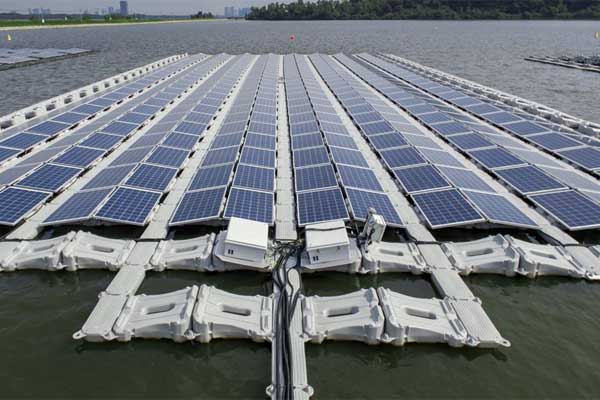- Floating solar panels (floatovoltaics) is increasingly being recognized as the next frontier for renewable energy.
- Despite its potential, it only makes up a small fraction of global solar installations.
- The current situation in Canada is even less inspiring, with not a single large-scale floatovoltaic farm in the country.
- As Toronto phases out its old fleet in favour of new, fully electric shuttles, there's an opportunity to develop a "landmark demonstration" with floatovoltaics.
Floating solar energy — dubbed “floatovoltaics”— is increasingly seen as the next frontier for renewable energy thanks to its enormous versatility and ability to solve a multitude of problems plaguing traditional solar technology.
Floating solar installations are designed to blanket a water’s surface with reflective panels sitting atop a buoyant base and are especially useful where land is at a premium. The panels shade the water below, helping conserve it by reducing evaporation. Floating panels also benefit from the water’s natural cooling properties, which help improve overall performance.
Despite the potential of floatovoltaics, they only make up a small fraction of global solar installations. The current situation in Canada is even less inspiring, with not a single large-scale floatovoltaic farm in the country.
Luckily, there is at least one project in the works, thanks to EnergyCostSaver Inc., based in Strathmore, Alberta. The company has partnered with Layfield, which specializes in floatation devices, and plans to build a 4MW system on top of some of the town’s contaminated ponds.
The lack of government support for floatovoltaics in Canada amounts to a squandered opportunity, as the country boasts the largest number of lakes (879,800) in the world, has ample coastline, and boasts excellent conditions for solar energy production.
Natural Resources Canada has acknowledged the significance of floatovoltaic technology but isn’t currently funding any projects. An agency spokesperson provided three primary reasons for Canada’s nonexistent support: the high cost relative to ground-mounted technology, limited sunlight hours at northern latitudes, and ice coverage concerns.
Yet, these claims aren’t necessarily supported by industry experts. According to Manish Kumar, a professor at Himachal Pradesh University in India who studies floatovoltaics, ice doesn’t negatively affect solar — and the cooler temperatures would likely boost overall efficiency.
The high cost of floatovoltaics relative to ground-mounted solar projects is a legitimate disadvantage, though not one that can’t be resolved. After all, just 15 years ago, all types of solar energy was regarded as uncompetitive and overly expensive. Now, it’s the cheapest form of electricity the world has ever seen. Investment spurs innovation which reduces costs and broadens market opportunities.
The final concern, that Canada lacks the radiance to support floatovoltaics, is nonsensical. In its criticism, Natural Resources Canada refers only to that of the northern latitude’s solar conditions, but floatovoltaics are by no means limited to this specific geographic boundary.
A recent study and proposal by Ibrahim Dincer, professor of mechanical engineering at Ontario Tech University, highlighted the strong potential for floatovoltaics to power Toronto Harbourfront’s water transit.
Currently, the city operates a fleet of four ferries, all of which rely on diesel fuel. But as the city phases out its old fleet in favour of new, fully electric shuttles, there’s an opportunity to develop a “landmark demonstration” with floatovoltaics.
As Toronto only operates a small fleet of boats, electrification through floatovoltaics wouldn’t make much of a dent in the city’s greenhouse gas emissions. But it would provide a statement about floating solar energy’s capabilities at a time when Canada’s approach to the technology has been tepid at best.
Nations like Japan and Thailand have shown that floating solar energy can substantially boost utility-scale energy production. And with Canada’s ample space for floatovoltaics — including contaminated tailing ponds, ocean coastlines, and spanning lakes — the industry represents a marked opportunity for Canada’s economy and its lagging climate efforts.













Comments